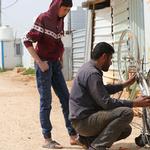Emergency urbanism in Sabra, Beirut
Since the mid-1980s, generations of displaced people have sought refuge in the ramshackle buildings that were once the Gaza-Ramallah Hospital, a multi-story hospital complex built by the Palestinian Liberation Organization (PLO). The hospital buildings are an example of emergency urbanism whereby displaced people seek refuge in cities offers a unique insight into shelter in displacement. The Gaza buildings’ history is an especially interesting one, due to the way it caters to both the wartime and post-war displaced and the ways the buildings’ form and function have changed to accommodate them. This means, as I argue towards the end of the presentation, not only analyzing the buildings as symbols or markers of historical epochs or periods, but as archives of spatial and political histories. Taking my cue from the need to understand refugee housing as a process, “housing as a verb,” the multi-story buildings can be read as a vertical migration history where generations of refugees and migrants have escaped conflict, displacement, and destitution. Examining the buildings’ transformation provides a genealogy of displacement and emplacement that can inform the study of emergency urbanism and identify solutions in cities for refugees lacking access to affordable housing.







